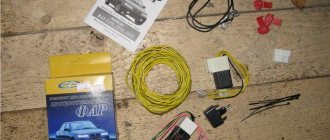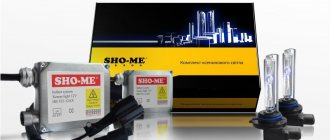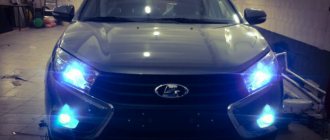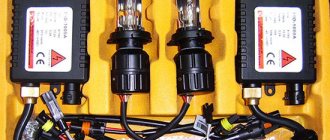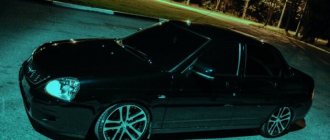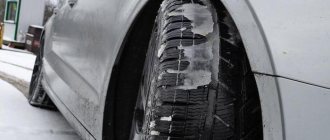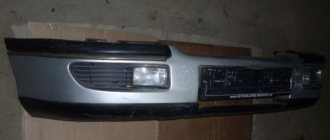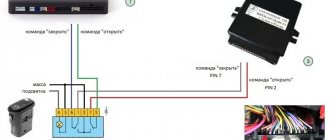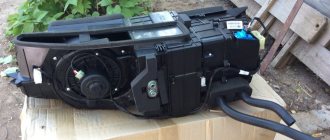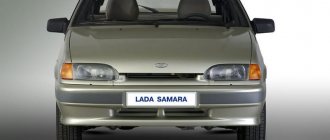The very possibility of installing xenon on the VAZ 2107, 2110 is there, but here everything is not so simple. There is a set of rules that stipulates, for example, that only gas-discharge lamps in lensed optics are allowed. In addition, only xenon can be installed, which has a headlight beam corrector, as well as a washer, which can guarantee high-quality lighting.
It is worth remembering that there are serious fines for driving a vehicle with lighting devices installed on the front part of which the operating mode or color of the lights does not meet the requirements. Gradually, the punishment for this violation moved from the category of fines to the category of deprivation of rights for a period of six months to twelve months.
It is important to note here that installing xenon is not always a reasonable action, because not every driver considers himself responsible for other road users, so “blinding” oncoming traffic can be done easily and simply, without thinking about the consequences. For this, there is not only contempt on the part of other road users, but also quite significant punishments that are guaranteed to remove you from the ranks of motorists for a significant period.
It is, as you understand, possible to physically install xenon on a foreign car, but it is worth remembering that almost all xenon lamps are prohibited by the rules. You will not be warned, you will not be given a fine - for the first violation of this rule, your driver's license will be confiscated for up to one year. It is extremely stupid to think that bright lights will be a problem only for those drivers who are driving towards you - only you are the culprit here, only you will be punished here. In addition, some note that the usefulness of xenon lamps is sharply overrated, because the visibility of the road is more influenced not by the volume of light, but by its correct direction, which illuminates the area at the desired angle.
Sometimes it gets to the point of stupidity when a car, which, as drivers say, is hung with “collective farm” xenon, which for some unknown reason is adapted for installation on vehicles, begins to glow like a Christmas tree. After such a flash of light, other drivers cannot see the road in front of them for several seconds, and you yourself know what this leads to. On the other hand, xenon can be useful when you are driving on rough terrain, away from other people, when you can easily illuminate the road the way you want.
It is quite possible to physically install xenon in lensed headlights on a car - specialists and not of the highest level of skill can handle this. Another thing is that you don’t need to do this if it’s not a car in which you go far outside the city, where you can safely illuminate the highway the way you want, or rather, not even a highway, but a country road, or a road in the middle of a forest. If you travel over rough terrain, xenon will help you feel comfortable, but on a regular road, where you will constantly meet other drivers, xenon is strictly prohibited.
In addition to the universal understanding that xenon simply blinds drivers who are driving in the opposite direction to you, there are also rules based on legislative acts that confirm that drivers who use these technologies in their cars will simply lose their driver status next year. On the other hand, as we have already noted, it is quite possible to physically install xenon in lensed headlights on a car. If you are a fan of fishing and like to travel far from the city, then with such lighting you will travel pleasantly and comfortably - you will definitely enjoy it and be safe.
The answer to the possibility of driving with xenon in 2017-18 is quite simple - no, you can’t. Indeed, without much debate, the law banning xenon headlights was not only confirmed, but also became much more stringent. The government has received confirmation from experts who assure that there is no need for xenon, and that the harm these lamps cause to other road users is incomparably greater than their usefulness. Illumination of the road using basic lamps is sufficient for even the least experienced driver to see the road surface perfectly and be able to navigate.
Let us note that there are no fines for this violation and there will not be any - it is so severe, so unambiguous that you will simply be deprived of your driver's license. It is worth recognizing that this is a very fair decision against the backdrop of the danger a driver with xenon headlights exposes other people to, blinding them, even if only for a few seconds, but on the road for very important ones. The quality of road illumination from xenon headlights does not improve significantly - the car simply begins to shine like a Christmas tree, while the correct illumination of the road is based on the desired direction of the headlights.
How to install xenon on a VAZ 2107
When traveling at night, the lighting of the roadway is very poor and it was for this reason that it was decided to install xenon. You can do this yourself, the main thing is to follow the manufacturer’s recommendations and our advice. Today I will tell you how to correctly install xenon on a VAZ 2107 with your own hands.
First of all, I want to show how the headlights originally shone:
Next, we disassemble the headlight, remove the protective cap and carefully drill a hole. We insert the rubber plug and pull the wires through it to the lamps and power connector:
It is worth noting that our website already has materials about installing xenon with your own hands on VAZ 2101, VAZ 2106, VAZ 2110 and Lada Priora cars.
Now you need to install the cover in place and secure the ignition units. We connect everything according to the diagram:
Installation time took approximately 25-30 minutes. Result in the photo:
The installation of xenon on a VAZ 2107 has been successfully completed. I recommend adjusting your headlights on a special stand so that you do not blind oncoming traffic. If you have free time, install the electric trunk opening drive on a VAZ 2107 with your own hands.
Conclusion
Bi-xenon on the VAZ 2114 will be an excellent solution for those who would like to slightly improve their own car. Such headlights will come in handy if the driver travels frequently and therefore has to be on the road even at night.
Those who are still wondering how to install xenon on a VAZ 2114 should be advised to take safety measures as carefully as possible. Many car enthusiasts ignore them, but if xenon is installed, this can lead to the most serious consequences for human health.
How to choose a good xenon kit?
The selection of a suitable xenon lighting source for a car should be based on two factors: the popularity and reliability of the manufacturer and the required brightness of the lamps.
What should a xenon kit consist of?
The complete set of gas-discharge bulbs for headlights or fog lights includes:
- lighting sources designed for a certain power and with specific markings;
- ignition device;
- a set of wires and elements for connecting and fixing lamps.
The ignition unit is a module designed to supply a certain amount of voltage required for activation to light sources. More expensive units have a more complex design, which allows them to control a larger number of processes. If the device is of high quality, it will be able to ensure long-term and uninterrupted operation of the light elements. This is due to the fact that when igniting the lamps, the basic technical parameters are observed within the required range.
Xenon marking
The marking of gas-discharge devices can be 5000K, 6000K, etc. This parameter determines the color temperature, that is, the brightness and shade of the light bulb. If the device marking is 4300K, then the light will be whiter and have a yellowish tint. The use of such sources is relevant in PTF and head optics. They are more effective when driving on wet roads.
Devices rated at 5000K have a white emission color. Their power is higher, and the light itself is more pleasant to perceive by the human eye. 6000K bulbs have a blue tint and, as a result of their low light output, are inferior in power to previous options. However, this type of device is more popular among our compatriots. As standard, when producing cars, companies install xenon lamps rated at 4200-5000K.
The AvtoGSM channel in the video unpacked and made a brief overview of the xenon equipment from the manufacturer Show-Mi.
Which xenon is better?
It is not a fact that an expensive set of gas-discharge light bulbs will function efficiently and effectively. When purchasing an ignition unit, it is also recommended to pay attention to the cost.
It is necessary to choose a device that matches the technical parameters of the machine. For example, if the car is not equipped with a module for monitoring the voltage of light bulbs, then it makes no sense to buy xenon with a “fake”. This will not affect the quality of his work in any way.
It is not advisable to purchase thin ignition units, called “slim”, if there is a lot of space in the engine compartment for installing a standard device. The cost of such “devices” is higher. And if the block is cheap, then, as a rule, it is made of low-quality materials, and the assembly also leaves much to be desired.
The most popular manufacturers of xenon lamps
Manufacturers of gas-discharge lighting sources that have positively proven themselves among consumers:
The Test Lab channel talked about the nuances that will allow you to distinguish the original Osram xenon from a fake.
Preparation for self-installation and connection of xenon in a car
Every driver can replace standard light bulbs and install xenon lights themselves. When performing installation, the main thing is to follow the manufacturer’s recommendations and follow the diagram.
In order not to damage the light bulbs, the bulb of the light source should not be touched with your fingers.
If this happens, then the surface with the imprint must be treated with a clean rag with alcohol. Before performing the task, be sure to disconnect the battery. When launched, gas-discharge light sources produce 23 thousand volts of voltage, which will be fatal to humans.
What may be required to connect?
To quickly install gas-discharge lighting sources, you will need:
- set of lamps;
- stationery knife or scissors;
- Phillips head screwdriver;
- plastic clamps;
- drill with 25 mm cutter;
- set of wrenches.
Xenon installation diagram
The installation and connection process is carried out as follows:
- First, old lighting sources are removed and new ones are installed in their place. To complete the task, the plastic protective cover installed on the optical instruments is dismantled. Electrical wiring is disconnected from halogen or incandescent lamps. Removing the device may require the release of a special retainer or clamp.
- The gas-discharge bulb is carefully removed from the protective bulb and mounted in the hole on the lantern. If a special clamp is used for fastening, it must be fixed. If there is a spring, the electrical circuit from the gas-discharge lamps must be pulled through this element. Afterwards, the wiring is routed through a plug into the engine compartment.
- Running an electrical circuit near the battery will be problematic. The battery usually blocks access to the flashlight, so it will have to be removed. After the lighting sources are installed, their contact elements are connected to the ignition unit.
- Then you need to make special holes in the plugs of the optical devices; the power line will be laid through them. If the protective casing is made of rubber, you must use scissors for installation. If the plug is made of metal, then you will have to drill a hole to pull the wire through it. A cutter is used for this; a 2.5 cm piece is best.
- After completing this task, a location for installing the ignition device is selected. It will be located next to optical instruments. It is important that the power supply circuit is not stretched.
- When installing the ignition unit, it is recommended to choose a place where the device will not be exposed to high temperatures, moisture, and dirt. These devices themselves are usually sealed, but it is better to take this rule into account. If there is no such place under the hood, then the device should be wrapped with tape or tape, this will partially increase its safety. The block is fixed using plastic clamps or tape.
Do-it-yourself installation of xenon on a VAZ 2106 car
According to automotive experts, installing xenon on the VAZ 2106 will significantly improve the driver’s ability to navigate in difficult visibility conditions and when driving at night in limited visibility conditions. Practitioners recommend this technological operation, as it will improve lighting several times. However, you should know that the price of xenon is quite high, and the pleasure of driving with xenon light is quite expensive.
It is possible to install xenon on a VAZ 2106 on your own if you have basic plumbing skills and basic knowledge in electrical engineering. For practical help on the Internet, you can watch the production video “xenon on the VAZ 2106 video”, which will provide practical assistance in carrying out repair and maintenance work.
We install xenon on the “six”:
- Initially, installation of ignition units is required.
- We drill holes in the body of the optics for laying high voltage wires.
- We install sealing gaskets in the holes to prevent condensation from appearing on the “six” headlights.
- We mount a gas-discharge lamp into the housing part of the optical system.
- It is necessary to take into account the fact that when installing xenon rather than bi-xenon lamps, the high beam electrical circuit of the headlights is activated during the connection process, which leads to the fact that when using the low beam, the high beam also lights up in parallel. To separate the two types of car light, a special diode device is installed.
- We install the optical system in the working position.
At this point, the installation of xenon on the VAZ 2106 is considered complete.
How to properly install and connect xenon to fog lights?
If xenon light sources were installed in the headlights, it is advisable to install them in the PTF. This will prevent you from spoiling the aesthetic appearance of the car.
Installation and Connection Precautions
Nuances that must be observed when installing gas-discharge devices in fog lights:
- If damage appears on the light sources during the task, you must stop working. This also applies to wiring defects, as well as ignition units.
- Before performing the task, the car owner must wash his hands, dry them and degrease them. Otherwise, the bulbs may be damaged and you may receive an electric shock.
- When connected, you should not look at the light sources for a long time without glasses.
- The joints are completely insulated using heat-shrinkable tubing or electrical tape. Otherwise, moisture may get into the wiring, which will lead to a short circuit or fire.
- Before mounting the light source bulbs, it is recommended to degrease them.
How to choose xenon
You should choose xenon with extreme caution. Quite often there are models on the market that cannot be called quite high quality, although they are quite expensive. What should you pay attention to first? All car owners are advised to check the brightness level. Too high brightness can lead to the most serious problems for the motorist, because bright headlights can temporarily blind traffic from the oncoming lane.
Brightness of xenon lamps
Installing xenon in fog lights (PTF)
Xenon is installed in foglights in the same way as in headlights, only it is still easier and faster. The main thing, after xenon appears in the PTF, is to lower the luminous flux of the fog lights down a little, so as not to blind oncoming drivers. The requirements for installing xenon in foglights are as follows: lenses must be installed in the headlights, the headlights must have a marking in the form of the letter “D”, which indicates that xenon lamps can be used in the headlights for lighting (the letter “H” indicates that in the headlights Only halogen lamps can be used).
What happens if you install xenon in headlights that are not designed for this?
What do you think? Firstly, with a 99% probability you will blind drivers of oncoming cars, and secondly (which is worse for you) if you are stopped by traffic police inspectors, you may lose your license for a period of 6 months to 1 year with confiscation of instruments and accessories. So it’s up to you to decide whether to install xenon according to all the rules or drive around and blind everyone you meet. By the way, humanity does not stand still and now people are already installing xenon lamps not only in headlights and PTF, but also in reverse, here, of course, no lenses or permits are needed, I think that no one will bother you for this, especially that parking in the dark, after installing xenon in reverse, will be a complete pleasure. In conclusion, I would like to say that installing xenon is not a complicated operation that anyone can do. The main thing is that if you decide to install it, then do it competently and do not save money, especially since there is nothing on the automotive market now and the choice of everything is simply huge at different prices and from different manufacturers. If you want to learn more about the light from xenon and halogen lamps, watch the following video:
Do I need to take precautions when installing xenon?
It should be remembered that installing xenon is by no means the safest activity. As many precautions as possible should be taken during this process. If any damage to the kit is noticed during installation, you must stop all work as soon as possible and consult your dealer.
Xenon installation
Another reason to stop installation work is numerous damage to ballasts and lamps.
Experienced craftsmen advise not to try to do the work with hands that have recently been stained with oil or any other liquid. In this case, you may get an electric shock.
During use, try to keep the headlights as clean as possible. Dirty headlights scatter the light and can blind oncoming drivers.
Xenon lamp
In addition, it is recommended to additionally install a high-pressure cleaner. It will make using headlights even easier.
How to replace xenon lamps with halogen ones yourself?
The disadvantages associated with the operation of xenon lead to the fact that many car owners decide to replace gas-discharge lamps with conventional ones. There are nuances in this process, especially if the light sources were installed regularly.
DIY lamp replacement procedure
Replacement is carried out after preparing a wrench and a screwdriver; sometimes electrical tape is required:
- The engine compartment is opened and the negative clamp is disconnected from the battery.
- Installed lighting sources are disconnected from the power supply circuit. The protective elements under which the screws are located are dismantled. They attach the optics to the car body, so they need to be unscrewed, but not completely, just loosened.
- The lights are dismantled. They can additionally be fixed using latches. When performing the task, it is important not to break the fastener. After this, the lighting device is dismantled from the seat.
- The ignition units for gas-discharge light bulbs are removed; for this, the fastenings on the modules are unscrewed.
- The power line is laid from the control unit, the device is mounted next to the steering wheel. If halogen bulbs were installed in cars, then there is no need to change the electrical circuits. But in the case of standard xenon, new cables will be required. This task is performed carefully so as not to damage the conductors.
- Optical devices are installed and connected to electrical circuits. Then the lighting flux is adjusted.
When is it possible?
And yet there is one possibility when LEDs and xenon can be installed in headlights. But, unfortunately, this opportunity will not make it any easier for us.
The fact is that the mandatory compliance of the light source with the headlight design is enshrined in the Basic Provisions of the Traffic Regulations. There is also a note that if the car is old and out of production, then you can install lighting devices from other models and even brands of cars on it.
Does this mean that VAZ can be equipped with other headlights, including those with xenon or LED? No, that doesn't mean it. According to the Technical Regulations, in any case, such a light source must be certified and tested as part of the vehicle on which it is installed. This means that if the old VAZ provided only halogen lamps, then the headlights will have to be installed only with a halogen light source.
In addition, with such an installation, you will have to go through the procedure of making changes to the design of the machine, which is quite labor-intensive and expensive.
Legal connection
You should know that the PTF may already have bi-xenon lamps and corresponding lenses installed from the factory. This is a PTF of the so-called class D, such a light is absolutely legal, inspectors cannot “find fault” with it.
To install xenon on a VAZ 2110 in foglights, as well as conventional headlights, it is necessary that the entire kit, which uses bi-xenon lamps, be legal. That is, these are, for example, licensed headlights or PTF. There must be a letter D on the glass itself, it is this that indicates that bi-xenon lamps need to be connected to this headlight. In this case, xenon is legal and will not cause any complaints.
If N is written on the headlight glass itself, then halogens are used here, and problems with the traffic police are quite likely.
An article dedicated to tuning the instrument panel in a VAZ 2110 car is located here:
What to do if xenon headlights stop working?
If xenon bulbs stop functioning, the reasons may be as follows:
- damage to the contact on the connector for connecting to the power circuit;
- broken wiring;
- failure of the lighting source, the lamps cannot be restored;
- control module failure.
Why does the ignition unit break?
Reasons for failure of the ignition device:
- Lack of tightness on the module body, which leads to dirt and moisture getting inside the unit. The problem can be determined by disassembling the device and diagnosing its internal components. If dirt or water gets into the module, the lights will not light up or will begin to blink when turned on.
- Negative effects of corrosion. The solder joints of electronic components may oxidize, causing components to fall out of the solder. The problem is associated with assembly errors or regular exposure to moisture.
- The pulse signal from the controller has disappeared. There may be problems with the transistor elements, multiplier or transformer device.
How to repair a xenon ignition unit yourself?
Module repair is performed as follows:
- All electrical circuits are diagnosed for breaks or leaks. This refers to the wires that go to the module. The problem may be a pinched or damaged power line.
- The device is treated with an alcohol solution, this will remove rust and traces of condensation. You must act carefully so as not to damage the board. The sealant is removed from the back of the circuit and the contact elements are re-soldered with a soldering iron. Everything needs to be soldered, since leaky parts are difficult to visually identify.
- An opened ignition device is diagnosed on something that does not allow voltage to pass through. When diagnosing, there are no parts that light up nearby. The test is performed while the device is connected to a light source. The voltage of the multiplying element is 35 kV, so if the unit is not turned on, then it will not be touched until it is completely turned off.
- The next step will be to perform diagnostics on the transistor elements, there are a total of four on the board. A multimeter is used to check. If testing shows a device with a breakdown, it is soldered again. It is recommended to install 4N60 parts.
- Using a tester, it is not always possible to determine an element with a breakdown. It may be necessary to remove each transistor before the ignition device is activated. You can turn it on briefly, for a couple of seconds.
- If the transistor elements are intact, the resistor devices are checked. The burnt out part is replaced with a new one.
When assembling the block, it is not recommended to use silicone sealant.
After hardening, this product is as hard as possible. If the transient device needs to be replaced in the future, opening the module will be problematic.
Video
The “Fire & Ice” channel presented instructions for troubleshooting problems in the operation of a standard ignition module using the example of a Mazda car.
"""""For skeptics: in the future, LENSES and GLASSES for lenses, or lensed optics will be purchased and installed""""" Hello everyone. As promised, I installed Sho-me 5000k bi-xenon. I picked up the box for 3 days , looked at it and put it back)))) And finally it matured))) And so in more detail:
To whom the information was useful, leave likes and comments. Subscribe. Happiness to everyone and fewer fools on the road))
For skeptics: in the future, LENSES and GLASSES for lenses, or lensed optics, will be purchased and installed
